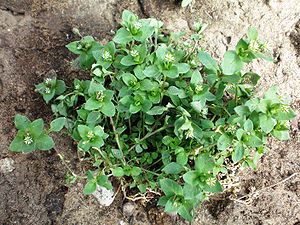Note: This is a project under development. The articles on this wiki are just being initiated and broadly incomplete. You can Help creating new pages.
Stellaria media - Chickweed
Chickweed, Stellaria media, is a cool-season annual plant native to Europe, but naturalized in many parts of North America. It is used as a cooling herbal remedy, and grown as a vegetable crop and ground cover for both human consumption and poultry. It is sometimes called common chickweed to distinguish it from other plants called chickweed. Other common names include chickenwort, craches, maruns, winterweed. The plant germinates in autumn or late winter, then forms large mats of foliage. Flowers are small and white, followed quickly by the seed pods. This plant flowers and sets seed at the same time.
Contents
Description
In both Europe and North America this plant is common in gardens, fields, and disturbed grounds. Control is difficult due to the heavy seed sets. Common Chickweed is very competitive with small grains, and can produce up to 80% yield losses among barley.
Stellaria media is widespread in North America, Europe and Asia. There are several closely related plants referred to as chickweed, but which lack the culinary properties of plants in the genus Stellaria. Plants in the genus Cerastium are very similar in appearance to Stellaria and are in the same family (Carophyllaceae). Stellaria media can be easily distinguished from all other members of this family by examining the stems. Stellaria has fine hairs on only one side of the stem in a single band and on the sepals. Other members of the family Carophyllaceae which resemble Stellaria have hairs uniformly covering the entire stem. It usually has 3 stamens other references indicate 5 stamens and 3 - 8 in other references.
Uses
- Stellaria media is edible and nutritious, and is used as a leaf vegetable, often raw in salads.[1] It is one of the ingredients of the symbolic dish consumed in the Japanese spring-time festival, Nanakusa-no-sekku.
- The plant has medicinal purposes and is used in folk medicine. It has been used as a remedy to treat itchy skin conditions and pulmonary diseases.
- Modern herbalists prescribe it for iron-deficiency anemia (for its high iron content), as well as for skin diseases, bronchitis, rheumatic pains, arthritis and period pain.[2] Not all of these uses are supported by scientific evidence.
